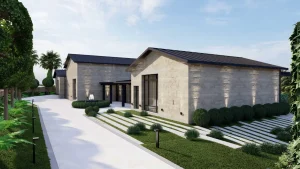Stable Ventilation Design is essential for the health and well-being of horses. A good ventilation system helps maintain air quality within the stable, protecting horses from respiratory diseases and improving their overall quality of life. Proper airflow inside the stable prevents the buildup of harmful substances like ammonia and dust, creating a clean environment. In this article, we will discuss the importance of stable ventilation design and how it can be effectively implemented.
Stable Ventilation Systems
Stable ventilation design must be specially designed to meet the needs of the horses and the physical characteristics of the stable. Effective air circulation in a stable removes trapped dirty air and allows fresh air to enter, positively impacting the horses’ respiratory system. Natural and mechanical ventilation methods form the foundation of stable ventilation systems.
Natural ventilation is achieved through windows, ventilation openings, and vents in the roof. These systems work depending on external weather conditions and regulate the airflow inside the stable. The advantage of natural ventilation is that it saves energy and is low-cost. However, in cases where weather conditions are unfavorable, natural ventilation may not be sufficient. Therefore, many stables also use mechanical ventilation systems.
Mechanical ventilation systems control the airflow inside the stable through fans and ventilation ducts. Stable ventilation fans are strategically placed throughout the stable to ensure the flow of clean air and expel dirty air. These fans are particularly effective in large stables and situations where natural ventilation is insufficient. Mechanical systems continuously maintain air circulation, balancing air quality inside the stable.
The Goal of Ventilation Efficiency
Stable Ventilation Design The effectiveness of stable ventilation systems is measured by the goal of ventilation efficiency. This efficiency relates to how quickly the air inside the stable is renewed and how effectively dirty air is expelled. To ensure stable ventilation systems work efficiently, proper design and placement are essential. Factors such as the size of the stable, the number of horses, the layout of the stable, and the climate conditions must be considered to achieve the goal of ventilation efficiency.
Stable Ventilation Design The size of the stable and the number of horses determine the capacity of the ventilation system. In a large stable or a facility housing many horses, a more powerful and comprehensive ventilation system may be required. Additionally, the climate conditions of the region where the stable is located also affect the ventilation design. In hot and humid climates, the ventilation system may need to be more robust.
Considerations for Proper Ventilation Design
When designing Stable Ventilation Design, there are several important factors to consider. First, elements that obstruct airflow inside the stable must be removed. Windows and ventilation openings in the stable should be placed to maximize airflow. Vents in the roof allow hot air inside the stable to escape, enhancing air circulation.
Controlling the humidity level inside the stable is also an essential part of ventilation design. High humidity levels can negatively affect horses’ health and lead to the growth of harmful organisms such as mold and fungi. Ventilation systems should be designed to reduce humidity and improve air quality inside the stable.
Another crucial point is the proper placement and regular maintenance of stable ventilation fans and other mechanical systems. The fans should distribute air evenly throughout the stable and be effective in all areas. Additionally, regular maintenance of the ventilation systems ensures their efficiency.
Durable Materials and Long-lasting Solutions
Stable ventilation systems should be made from durable materials and provide long-lasting solutions. Stable conditions require ventilation systems to operate continuously, so the materials must be robust. Durable materials like stainless steel and galvanized metal ensure that ventilation systems function smoothly for a long time. Moreover, water and dust-resistant fans and other mechanical parts extend the system’s lifespan.
Regular maintenance of stable ventilation systems ensures long-lasting and efficient use. Cleaning fans and air ducts, preventing blockages, and regularly checking motors help the ventilation systems run smoothly. Additionally, monitoring the system’s performance and making adjustments as needed keeps air quality high inside the stable.
Cost and Energy Efficiency of Stable Ventilation Systems
When designing stable ventilation design, energy efficiency should also be considered. Using energy-efficient fans and mechanical systems reduces both environmental impact and operational costs. Natural ventilation methods should be considered as an energy-saving option. However, in cases where natural ventilation is insufficient, energy-efficient mechanical systems should be preferred.
Conclusion
Stable Ventilation Design is a vital process for the health and well-being of horses. A good ventilation system maintains air quality inside the stable, positively impacting horses’ respiratory systems. Stable ventilation systems regulate the airflow inside the stable, ensuring a constant supply of fresh air. The goal of ventilation efficiency measures how quickly the air inside the stable is renewed and how effectively dirty air is expelled. Stable ventilation fans and other mechanical systems are designed to balance air quality inside the stable.
When designing stable ventilation systems, attention should be given to using durable materials and ensuring energy efficiency. Regular maintenance and proper placement of stable ventilation systems keep air quality consistently high and protect the health of the horses.




